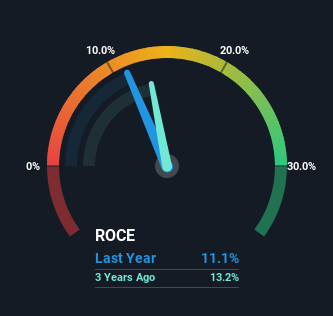- Japan
- /
- Construction
- /
- TSE:1828
Investors Could Be Concerned With Tanabe Engineering's (TSE:1828) Returns On Capital

If you're not sure where to start when looking for the next multi-bagger, there are a few key trends you should keep an eye out for. Firstly, we'd want to identify a growing return on capital employed (ROCE) and then alongside that, an ever-increasing base of capital employed. Ultimately, this demonstrates that it's a business that is reinvesting profits at increasing rates of return. However, after investigating Tanabe Engineering (TSE:1828), we don't think it's current trends fit the mold of a multi-bagger.
Understanding Return On Capital Employed (ROCE)
Just to clarify if you're unsure, ROCE is a metric for evaluating how much pre-tax income (in percentage terms) a company earns on the capital invested in its business. To calculate this metric for Tanabe Engineering, this is the formula:
Return on Capital Employed = Earnings Before Interest and Tax (EBIT) ÷ (Total Assets - Current Liabilities)
0.11 = JP¥2.7b ÷ (JP¥46b - JP¥22b) (Based on the trailing twelve months to March 2024).
So, Tanabe Engineering has an ROCE of 11%. In absolute terms, that's a satisfactory return, but compared to the Construction industry average of 7.9% it's much better.
View our latest analysis for Tanabe Engineering

Historical performance is a great place to start when researching a stock so above you can see the gauge for Tanabe Engineering's ROCE against it's prior returns. If you'd like to look at how Tanabe Engineering has performed in the past in other metrics, you can view this free graph of Tanabe Engineering's past earnings, revenue and cash flow.
How Are Returns Trending?
When we looked at the ROCE trend at Tanabe Engineering, we didn't gain much confidence. Over the last five years, returns on capital have decreased to 11% from 14% five years ago. However, given capital employed and revenue have both increased it appears that the business is currently pursuing growth, at the consequence of short term returns. And if the increased capital generates additional returns, the business, and thus shareholders, will benefit in the long run.
On a side note, Tanabe Engineering's current liabilities are still rather high at 48% of total assets. This can bring about some risks because the company is basically operating with a rather large reliance on its suppliers or other sorts of short-term creditors. While it's not necessarily a bad thing, it can be beneficial if this ratio is lower.
What We Can Learn From Tanabe Engineering's ROCE
In summary, despite lower returns in the short term, we're encouraged to see that Tanabe Engineering is reinvesting for growth and has higher sales as a result. And the stock has done incredibly well with a 150% return over the last five years, so long term investors are no doubt ecstatic with that result. So while the underlying trends could already be accounted for by investors, we still think this stock is worth looking into further.
On a final note, we found 2 warning signs for Tanabe Engineering (1 is potentially serious) you should be aware of.
While Tanabe Engineering isn't earning the highest return, check out this free list of companies that are earning high returns on equity with solid balance sheets.
Valuation is complex, but we're here to simplify it.
Discover if Tanabe Engineering might be undervalued or overvalued with our detailed analysis, featuring fair value estimates, potential risks, dividends, insider trades, and its financial condition.
Access Free AnalysisHave feedback on this article? Concerned about the content? Get in touch with us directly. Alternatively, email editorial-team (at) simplywallst.com.
This article by Simply Wall St is general in nature. We provide commentary based on historical data and analyst forecasts only using an unbiased methodology and our articles are not intended to be financial advice. It does not constitute a recommendation to buy or sell any stock, and does not take account of your objectives, or your financial situation. We aim to bring you long-term focused analysis driven by fundamental data. Note that our analysis may not factor in the latest price-sensitive company announcements or qualitative material. Simply Wall St has no position in any stocks mentioned.
Have feedback on this article? Concerned about the content? Get in touch with us directly. Alternatively, email editorial-team@simplywallst.com
About TSE:1828
Tanabe Engineering
Engages in plant construction and machinery production activities in Japan.
Flawless balance sheet 6 star dividend payer.

